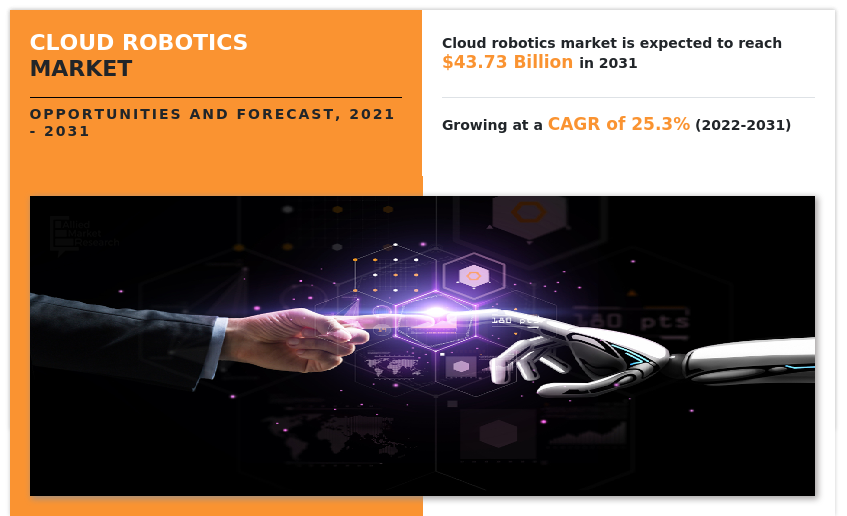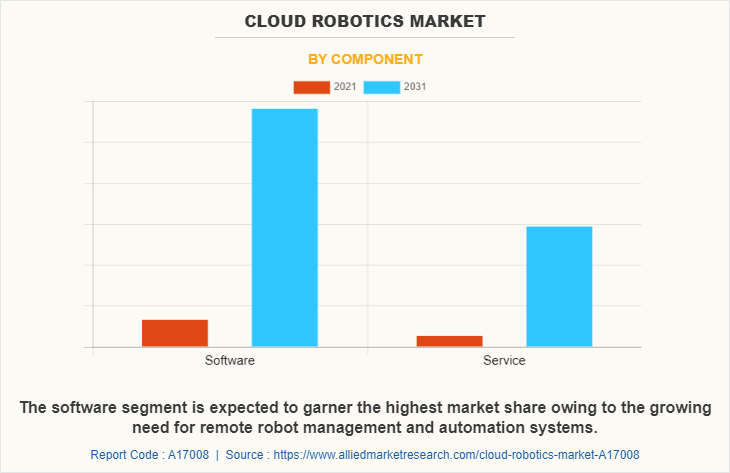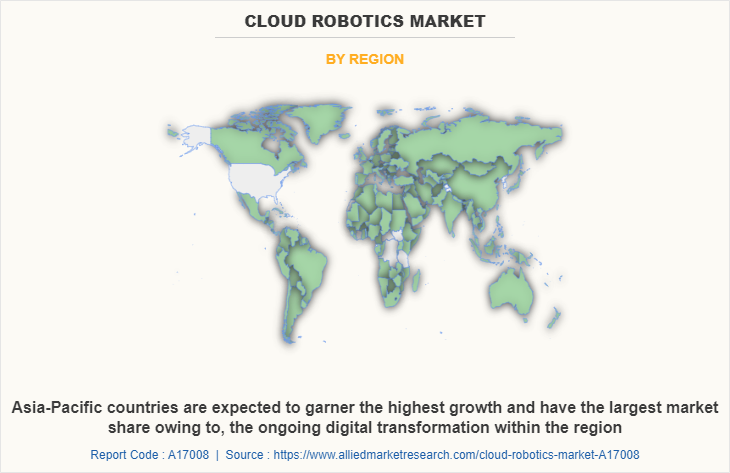Cloud Robotics Market Size & Trends
The global cloud robotics market size was valued at USD 4.62 billion in 2021 and is projected to reach USD 43.73 billion by 2031, growing at a CAGR of 25.3% from 2022 to 2031.
The rise in demand for work from home and remote working tools during the period of the COVID-19 pandemic aided in propelling the growth of the global cloud robotics market. However, the complex security and privacy challenges of the cloud robotics platforms can hamper the cloud robotics market forecast. On the contrary, a positive drive toward centralized monitoring and control of industrial tools is expected to offer remunerative opportunities for expansion of the market during the forecast period.

Cloud robotics is a branch of robotics that attempts to use cloud technologies such as cloud computing, cloud storage, and other Internet technologies to support robotics by leveraging the benefits of converged infrastructure and shared services. When networked to the cloud, robots can take advantage of the tremendous processing, storage, and communication resources of current cloud data centers, which can analyze and exchange information from several robots or agents (other machines, smart objects, humans, and others).
Segment Review
The cloud robotics industry is segmented on the basis of component, service model, robot type, enterprise size, industry vertical, and region. On the basis of component, the industry is divided into software and services. Depending on the service model, the market is classified into IaaS, PaaS, and SaaS. Based on robot types, the market is segmented into industrial robots and service robots. On the basis of enterprise size, the industry is segmented into large enterprises and small & medium enterprises. The industry vertical covered in the study include manufacturing, healthcare, aerospace & defense, media & entertainment, logistics, and others. Region wise, it is analyzed across North America, Europe, Asia-Pacific, and LAMEA.
The key players profiled in the cloud robotics market analysis are ABB, Amazon Robotics, C2RO, Calvary Robotics, CloudMinds, Fanuc Corporation, Google, Hit Robot Group, Huawei, IBM, Kuka AG, Microsoft, Ortelio Ltd., Rapyuta Robotics Co. Ltd., Rockwell Automation Inc., V3 Smart Technologies, and XTend Robotics. These players have adopted various strategies to increase their market penetration and strengthen their position in the cloud robotics industry.
Depending on component, the software segment dominated the cloud robotics market share in 2021, and is expected to continue this trend during the forecast period, owing to rise in demand for industrial robotics. However, the service segment is expected to witness the highest growth in the upcoming years, owing to large-scale deployments of robots, thereby fueling the demand for managed cloud robotic services.

Region wise, the cloud robotics market was dominated by Asia-Pacific in 2021 and is expected to retain its position and maintain the highest growth during the forecast period, owing to its growing technological investments and innovative robotics sector, which is aiding the cloud robotics trends within the region.

The report focuses on growth prospects, restraints, and analysis of the global cloud robotics market trends. The study provides Porter’s five forces analysis to understand the impact of various factors, such as bargaining power of suppliers, competitive intensity of competitors, threat of new entrants, threat of substitutes, and bargaining power of buyers on the global cloud robotics market share.
Top Impacting Factors:
Improving Communications and Internet Technology
Outside of the traditional benefits that cloud integration can provide such as artificial intelligence, machine learning, data analytics, storage, security, and computation services, improving communications standards are also enabling cloud robotics to integrate the functionalities of edge computing and benefits of ultra-low network latency with the help of modern 5G networks. With faster communication networks, robots and system automation have shifted from being the future innovations of the research labs to actually becoming a crucial cost, time, and energy-saving element of modern industries and businesses. Intelligent robots and their control systems have enabled entire processes, like vehicle assembly, to be carried out automatically. By adding mobility to the mix, the possibilities to include system automation in almost any industry increases dramatically.
Moreover, the basic characteristic that determines the stability and operability of cloud-controlled robot control is the network latency, and so for most use cases, 4G is a good starting point to provide connectivity. But with newer technologies such as 5G, which supports a wider range of requirements including sub-millisecond latency, it can fulfill both the bandwidth and latency needs that applications such as remote-control robotics may require. Furthermore, sub-millisecond latency is needed when touch or force sensors are used to maintain control over robot movement, as sub-millisecond latency can allow superior and near real-time control over a robot’s movement. Such advancements in communication technologies are promising great prospects for the future of the cloud robotics industry.
Growing Demand for Automation in The Industrial and Manufacturing Sectors
Many critical industrial operations such as painting, machining, material handling, welding, and assembling are now being replaced by automated robots. These robots use electrical, mechanical, and software systems which can exceed the performance, speed, accuracy, and precision of a regular human worker. Moreover, automation in industrial robots has been very successful, owing to its high precision and speed in structured factory environments.
However, these robots need to be integrated with a strong network and communication infrastructure, in order to be deployed in such environments. Thus, industrial robots are now being interconnected through the help of the cloud, enabling them to remotely access datasets to support different types of functions. Hence, automation in industries is expected to boost the global cloud robotics market growth during the forecast period.
Key Benefits for Stakeholders:
- This report provides a quantitative analysis of the market segments, current trends, estimations, and dynamics of the cloud robotics market analysis from 2021 to 2031 to identify the prevailing cloud robotics market opportunities.
- The market research is offered along with information related to key drivers, restraints, and opportunities.
- Porter's five forces analysis highlights the potency of buyers and suppliers to enable stakeholders make profit-oriented business decisions and strengthen their supplier-buyer network.
- In-depth analysis of the cloud robotics market segmentation assists to determine the prevailing market opportunities.
- Major countries in each region are mapped according to their revenue contribution to the global market.
- Market player positioning facilitates benchmarking and provides a clear understanding of the present position of the market players.
- The report includes the analysis of the regional as well as global cloud robotics market trends, key players, market segments, application areas, and market growth strategies.
Cloud Robotics Market Report Highlights
| Aspects | Details |
| By Component |
|
| By Service Model |
|
| By Robot Type |
|
| By Enterprise Size |
|
| By Industry Vertical |
|
| By Region |
|
| Key Market Players | XTend Robotics, Ortelio Ltd., Rockwell Automation Inc., Amazon Robotics, Fanuc Corporation, IBM Corporation, Calvary Robotics, Hit Robot Group, Huawei, Kuka AG, CloudMinds, V3 Smart Technologies, C2RO, Google, Microsoft Corporation, ABB, Rapyuta Robotics Co. Ltd. |
Analyst Review
Demand for cloud robotics platforms has been on a rise for the past few years and the market is expected to continue this trend in the coming years as well, owing to growing trends toward industrial automation and IoT, which are enabling the development of cloud robotics-based applications that can help provide efficient workload management and lower employee costs. Moreover, increase in advancements in artificial intelligence and machine learning technology are proving to be beneficial for the development of cloud robotics technology in the coming years.
Key providers of the cloud robotics market such as Alphabet Inc., Amazon.com, Inc., and Huawei Technologies Co., Ltd. account for a significant share of the market. With larger requirements from cloud robotics, various companies are establishing partnerships to increase cloud robotics capabilities. For instance, in June 2022, Schaeffler Technologies AG & Co. KG. announced a partnership with the Institute of Robotics and Mechatronics to reimagine the shopping experience using AI-enabled applications and services. Under this partnership, Schaeffler and the Institute of Robotics and Mechatronics are expected to combine their R&D labs to inspire new innovations in the field of robotics and automation.
In addition, with the increase in demand for cloud robotics, various companies are expanding their current product portfolio with increase in diversification among customers. For instance, in June 2022, DOBOT, one of the world-leading manufacturers of intelligent robots, announced the product launch of the CR3L Collaborative Robot. The DOBOT CR3L is an ultra-long cobot with a reach of 1,700 mm, an increase by 11.5% as compared to the previous version of the DOBOT CR Series, e.g. CR10, which had a max reach of 1,525 mm. The robotic body of the CR3L enables performing in small spaces, perfect for applications requiring extended reach for robots, such as loading and unloading, sorting, and wide-range inspection of small parts in consumer electronics and semiconductor industries.
Moreover, market players are expanding their business operations and customers by increasing their acquisitions. For instance, in May 2022, “stow Robotics” announced the acquisition of iFollow SAS. With this acquisition, “stow Robotics” aims to strengthen its robotics product offerings.
The global cloud robotics market size was valued at USD 4.62 billion in 2021 and is projected to reach USD 43.73 billion by 2031
The global cloud robotics market is expected to grow at a compound annual growth rate (CAGR) of 25.3% from 2021-2031 to reach USD 43.73 billion by 2031
Major key players in the cloud robotics market research report ABB, Amazon Robotics, C2RO, Calvary Robotics, CloudMinds, Fanuc Corporation, Google, Hit Robot Group, Huawei, IBM, Kuka AG, Microsoft, Ortelio Ltd., Rapyuta Robotics Co. Ltd., Rockwell Automation Inc., V3 Smart Technologies, and XTend Robotics.
Asia-Pacific is expected to witness significant growth during the forecast period
The rise in demand for work from home and remote working tools during the period of the COVID-19 pandemic aided in propelling the growth of the global cloud robotics market. A positive drive toward centralized monitoring and control of industrial tools is expected to offer remunerative opportunities for expansion of the market during the forecast period.
Loading Table Of Content...



